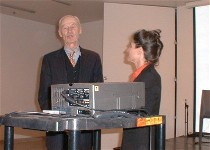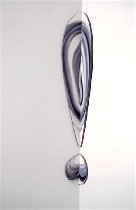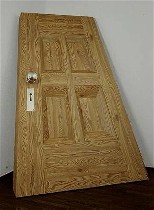
Artist Richard Artschwager, now 80, and former ICA Director Suzanne Delehanty (now director of the Miami Art Museum) walked down memory lane yesterday, sharing their memories of their experiences at the ICA in the 1970s (shown, Artschwager talking with ICA Senior Curator Ingrid Schaffner before the program).
Their public conversation was in celebration of the ICA’s 40 years of defying Philadelphia stodginess by exhibiting art on the cutting edge when just which way the knife would cut was often less than clear.
The 1979 Artschwager show here was his first solo museum exhibition, and the beginning of a series of important exhibitions for him at places like the Whitney in New York, the Foundation Cartier in Paris, and the Serpentine Gallery in London, said ICA Senior Curator Ingrid Schaffner, who introduced the talk.
The oner
 Schaffner said Artschwager’s art was related to a number of trends in art of the period but didn’t quite fit any one of them. His work was sort of Pop, but did not celebrate pop culture. It was about seeing, but not about what the camera saw. She noted his industrial materials, like formica and celotex, and his barely sublimated love of craft (shown, “Corner Exclamation”).
Schaffner said Artschwager’s art was related to a number of trends in art of the period but didn’t quite fit any one of them. His work was sort of Pop, but did not celebrate pop culture. It was about seeing, but not about what the camera saw. She noted his industrial materials, like formica and celotex, and his barely sublimated love of craft (shown, “Corner Exclamation”). Basically, the work is not like anyone else’s and tough to pigeonhole.
Delehanty set the scene in the ’70s of an America in upheaval, the political backdrop including the war in Vietnam, Watergate, Earth Day and the women’s movement. Artists were working in lots of different ways, including Artschwager.
 Artschwager later said to Delehanty, “Being original is the job…how to distinguish yourself from the other 1 billion 9 million 900 thousand 999.” He was including all the people who ever had lived and who ever would live. “We arrive here for four-score but then you’re going to be absent for a zillion years.” He’s thinking big, here, as well as funny, an approach that marked the rest of his comments as well (shown, “Chaise Eclatee 1”).
Artschwager later said to Delehanty, “Being original is the job…how to distinguish yourself from the other 1 billion 9 million 900 thousand 999.” He was including all the people who ever had lived and who ever would live. “We arrive here for four-score but then you’re going to be absent for a zillion years.” He’s thinking big, here, as well as funny, an approach that marked the rest of his comments as well (shown, “Chaise Eclatee 1”). And then he explained his use of perspective and framing devices and small images in just those terms–“Nobody’s doing perspective, so do it with a vengeance,” he said (shown, “Door”).
And then he explained his use of perspective and framing devices and small images in just those terms–“Nobody’s doing perspective, so do it with a vengeance,” he said (shown, “Door”).Blps
Artschwager’s blps, conceptual blots that could be applied anywhere, were based on an idea to make a period (as in a punctuation mark), and to make it big enough to have a presence that felt like it was covering something, like a felt-tip eradicated pair of eyes in a photograph, he said.
 Vertically, he said, the blps (“Blps” shown, left) were anthropomorphic. Horizontally, they were landscape. Rounder, and they suggested a time element, a clock, and how long it took to make that mark.
Vertically, he said, the blps (“Blps” shown, left) were anthropomorphic. Horizontally, they were landscape. Rounder, and they suggested a time element, a clock, and how long it took to make that mark.
“I labored with this thing two or three years and drove it into the ground and had to think of something else to do,” he quipped.
Unique generics
Delehanty wanted to know why he chose to make a sculpture of a piano that was clunky.
“This came about because a Martian came to earth and took a lot of notes,” said Artschwager. But the notes were incomplete. So the piano is sort of a generic piano. Artschwager was thinking about generic as a way to make art.
Delehanty asked, “How about the formica? I think you might have a new answer, today.”
 Armstrong did have a new answer. “I’m a sucker for auctions,” he said. So for $100, he got a pile of formica with a walnut grain in black and white, “as if a piece of walnut had passed through the formica and left a residue,” he said (shown, “Ladder”). He liked the formica as a 2-D collage material with colors and patters you can buy by the yard.
Armstrong did have a new answer. “I’m a sucker for auctions,” he said. So for $100, he got a pile of formica with a walnut grain in black and white, “as if a piece of walnut had passed through the formica and left a residue,” he said (shown, “Ladder”). He liked the formica as a 2-D collage material with colors and patters you can buy by the yard.
Asked by Delehanty if people were right in saying his art was distant and cool, his answer was, “Yes. [pause] It minds its own business. …If you want to visit it, OK.”
 He delivered a defense of Matisse, whose work, he said, was written about simperingly as pure expressions of color and form, at which point Artschwager pretended to stick his finger down his throat for the universal barf symbol. Matisse’s spaces are more convincing than reality, Artschwager said (shown, Artschwager’s “Destruction 6”).
He delivered a defense of Matisse, whose work, he said, was written about simperingly as pure expressions of color and form, at which point Artschwager pretended to stick his finger down his throat for the universal barf symbol. Matisse’s spaces are more convincing than reality, Artschwager said (shown, Artschwager’s “Destruction 6”).
Personal history
Delehanty asked why Artschwager, who was supposed to study science like his father before him, chose art. For one thing his father confessed to being a charlatan, in a conversation that clearly shocked the younger Artschwager. But then Artschwager added, “It was a remark by my first wife. You really don’t have the temperament of a scientist. You should be an artist. And I said, OK.”
Delehanty’s last question: If you had to make a Faustian bargain, what would you want and what would the price be?
Artschwager’s answer: I did it a long time ago. Margarite is the originality. You make a pact with the devil because you really want to get in her pants.”
After the discussion broke up, Artschwager distanced himself from analysis, saying art was about looking.
“We look all day.” It’s important not to drown out the art with analysis. Historians and critics are ok, but they make their own kind of poetry.”
The conversation was part deux of the ICA’s 40th Anniversary Celebration. The next part will feature a conversation between artist Laurie Anderson and former ICA Director Janet Kardon March 24. Others on the docket include Ann Hamilton, Judith Tannenbaum, and Lisa Yuskavage.









